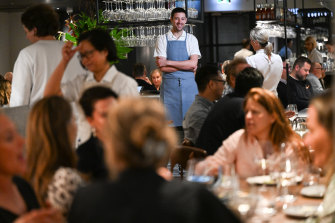The City of Melbourne’s pandemic stimulus meal voucher scheme has lured suburbanites back into CBD eateries in substantial numbers, throwing a lifeline to the city centre’s struggling hospitality sector.
Data for the $100 million Melbourne Midweek Money scheme – designed to help get the city buzzing again between Mondays and Thursdays – shows the most subsidised meals for non-locals went to residents of Werribee, 32 kilometres to the west of the CBD, who made nearly 1240 claims.

Brandan Katich, head chef at Nomad restaurant, says the dining scheme helped “super charge” weeknights during the COVID-19 recovery period.Credit:Joe Armao
Diners from Glen Waverley, Sunshine and Box Hill also proved willing to trek into the city, lured by a 25 per cent discount at their restaurant, cafe or pub. They spent an average of $155 each on their meals, $40 more than the locals, during the second phase of the stimulus scheme, which ran from early March to mid-April.
The council believes that more than half of the 850,000 people who had discount meals went on to spend $200 or more on shopping or entertainment while they were in the city, and that the scheme helped increase pedestrian numbers in key night-time economy spots such as Southbank, Chinatown and Lygon Street by up to 42 per cent from January to March.
The city’s hospitality sector badly needed a boost after the long lockdowns and work from home periods of 2020 and 2021, with trading conditions for cafes only back to about 40 per cent of pre-COVID levels in February this year, according to ANZ bank.
At Nomad restaurant on Flinders Lane, head chef Brendan Katich says the voucher scheme, jointly funded by the council and state government, helped “supercharge” weeknights during the recovery period.
“I would say it definitely would have added to our trade by at least … 30 or 40 per cent, there was just so many more bums on seats, especially in that time when Melbourne was coming back,” Katich said.
“That was just like a supercharged six to eight weeks when [the scheme] just really motivated people to get out there and then they spent really well, I think, more so than they would have otherwise.”








